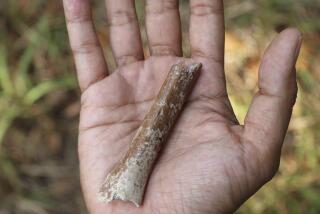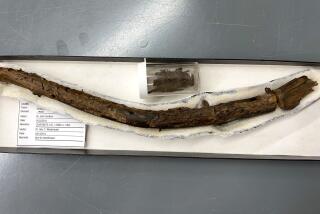Underwater fossils on shrunken Bahamian island hold key to Ice Age extinctions
Scientists have long wondered what caused the dramatic extinctions of many different species of animals, from woolly mammoths to saber-tooth cats, in different regions of the world 10,000 to 11,000 years ago.
Some have argued that dramatic climate changes occurring around the same time, a period known as the Pleistocene Holocene transition, were to blame. Others said the incursion of humans, with their hunting practices and their propensity to dramatically alter habitats, were the driving force in these species’ disappearance.
Now, by examining an underwater fossil site discovered in the Bahamas, researchers have been able to distinguish between these two forces — and found that human encroachment appears to have been more devastating than even severe climate change, according to a new study in the Proceedings of the National Academy of Sciences.
See the most-read stories in Science this hour >>
The new fossils “gave us an unparalleled snapshot at what the Ice Age life would have been like on a Caribbean isle,” said lead author David Steadman, curator of ornithology at the Florida Museum of Natural History.
Islands are ideal ecological laboratories: Their isolation makes it easier to figure out what factors are contributing to a species’ development (or demise). That’s true if you’re comparing species across islands, as Charles Darwin did at the Galapagos Islands, and it’s true if you’re looking back in time on a single isle, digging through the fossil record.
Studies have indicated that there seems to be a pattern on many islands: As soon as humans get there, whether it’s 10,000 years ago or 2,000 years ago, many species seem to quickly vanish. But it was not entirely clear whether humans or other natural factors were to blame. (It’s a debate still playing out around California fossil sites, including the La Brea tar pits.)
The new study helps to clarify this difference thanks to a rich collection of fossils discovered by an experienced scuba diver (study coauthor Brian Kakuk) in a flooded sinkhole on the Bahamian island of Abaco.
“As the first fossils started to come … I could tell that this was a really unusual site and could probably inform us about things that no other site on a Caribbean island, that any of the previous sites could,” Steadman said.
This collection of bones, probably gathered by predators bringing home their meals, contains more than 5,000 fossils from 96 different vertebrate species — 13 fishes, 11 reptiles, 63 birds and eight mammals. Out of those 95 species, 39 of them (or 41%) have disappeared from Abaco. Were those losses from climate change or from the presence of humans for the last 1,000 years or so?
Because these bones are now submerged in water, they must have been placed there a long time ago — before the sea levels rose, during the Pleistocene epoch, which ended about 11,700 years ago. The scientists could compare this to more recent fossils found on the island that are from the more recent Holocene era (from 11,700 years to the present) to see which ones survived the climate change surrounding that transition. They could also compare them to current species on the island, to see which ones have survived the relatively recent human presence.
The scientists found that of the 39 species that went extinct, 17 (less than 44%) of those disappearances were due to climate change. The other 22 (more than 56%) were able to survive this tumultuous period but had disappeared since humans arrived.
SIGN UP for the free Great Reads newsletter >>
So the majority of the extinct species were wiped out after humans came on the scene, not by extreme climate change. And keep in mind, climate change on Abaco during the transition between the Pleistocene and Holocene, around 15,000 to 9,000 years ago, was no joke. As the glaciers melted and sea level rose, Abaco’s real estate shrunk more than tenfold, from about 17,000 square kilometers to 1,214 square kilometers. The climate also became warmer and wetter, favoring more broadleaf forests over the pine woodland that once dominated.
“In a way there’s some real irony here because any of the species that were alive a thousand years ago on Abaco when people first arrived were pretty darn resilient — in other words, they’re the ones that could handle the island getting smaller, the habitat changing and all that,” Steadman said. “But when people show up and they start burning the forest in the dry season and things like that, that’s a tough one to adapt to.”
Steadman says researchers are going to try and study fossils from similar underwater assemblages around other islands in the Bahamas to further fill in the story. And he added that understanding the traits of species that were able to survive both natural and human-caused change could help researchers predict which ones are likely to survive the continued, and increasing, human presence.
“The ones that have been resilient to both climate change and human presence — those are probably the next ones we should focus on,” Steadman said. “Because they’re the ones most likely to make it.”
Follow @aminawrite on Twitter for more fascinating science news.
ALSO
Will California’s end-of-life law push lethal drugs over costlier care?
Study finds plastic debris and man-made fibers in fish sold in markets
Discovery of 47 teeth in Chinese cave changes picture of human migration out of Africa







